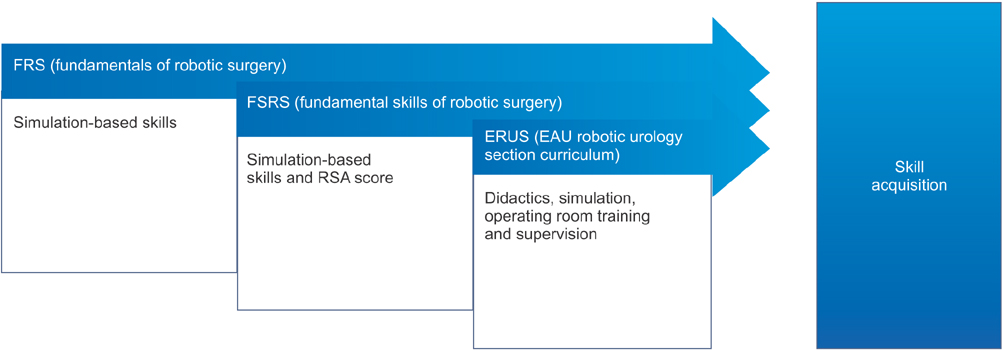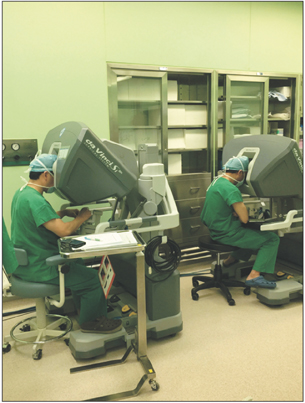Investig Clin Urol.
2016 Dec;57(Suppl 2):S114-S120. 10.4111/icu.2016.57.S2.S114.
Proctorship and mentoring: Its backbone and application in robotic surgery
- Affiliations
-
- 1Department of Urology and Urological Science Institute, Yonsei University College of Medicine, Seoul, Korea. khrha@yuhs.ac
- 2Department of Urology, Tanta University Medical School, Tanta, Egypt.
- KMID: 2361677
- DOI: http://doi.org/10.4111/icu.2016.57.S2.S114
Abstract
- In pursuit of continuing medical education in robotic surgery, several forms of training have been implemented. This variable application of curriculum has brought acquisition of skills in a heterogeneous and unstandardized fashion from different parts of the world. Recently, efforts have been made to provide cost effective and well-structured curricula with the aim of bridging the gap between formal fellowship training and short courses. Proctorship training has been implicated on some curriculum to provide excellent progression during the learning curve while ensuring patient safety.
Keyword
MeSH Terms
Figure
Reference
-
1. Da Vinci Surgical System [Internet]. Sunnyvale (CA): Intuitive Surgical Inc.;c2016. cited 2016 Jul 30. Available from: http://www.intuitivesurgical.com.2. Seo IY. Urologic robotic surgery in Korea: past and present. Korean J Urol. 2015; 56:546–552.3. Kim DK, Rha KH. Supporting evidence for robotic urological surgery. Korean J Urol. 2015; 56:733–734.4. Nishimura K. Current status of robotic surgery in Japan. Korean J Urol. 2015; 56:170–178.5. Fisher RA, Dasgupta P, Mottrie A, Volpe A, Khan MS, Challacombe B, et al. An over-view of robot assisted surgery curricula and the status of their validation. Int J Surg. 2015; 13:115–123.6. Marguet CG, Young MD, L'Esperance JO, Tan YH, Ekeruo WO, Preminger GM, et al. Hand assisted laparoscopic training for postgraduate urologists: the role of mentoring. J Urol. 2004; 172:286–289.7. Zorn KC, Gautam G, Shalhav AL, Clayman RV, Ahlering TE, Albala DM, et al. Training, credentialing, proctoring and medicolegal risks of robotic urological surgery: recommendations of the society of urologic robotic surgeons. J Urol. 2009; 182:1126–1132.8. Peters JH, Fried GM, Swanstrom LL, Soper NJ, Sillin LF, Schirmer B, et al. Development and validation of a comprehensive program of education and assessment of the basic fundamentals of laparoscopic surgery. Surgery. 2004; 135:21–27.9. Hung AJ, Jayaratna IS, Teruya K, Desai MM, Gill IS, Goh AC. Comparative assessment of three standardized robotic surgery training methods. BJU Int. 2013; 112:864–871.10. Smith R, Patel V, Satava R. Fundamentals of robotic surgery: a course of basic robotic surgery skills based upon a 14-society consensus template of outcomes measures and curriculum development. Int J Med Robot. 2014; 10:379–384.11. Dulan G, Rege RV, Hogg DC, Gilberg-Fisher KM, Arain NA, Tesfay ST, et al. Developing a comprehensive, proficiency-based training program for robotic surgery. Surgery. 2012; 152:477–488.12. Chowriappa AJ, Shi Y, Raza SJ, Ahmed K, Stegemann A, Wilding G, et al. Development and validation of a composite scoring system for robot-assisted surgical training--the Robotic Skills Assessment Score. J Surg Res. 2013; 185:561–569.13. Stegemann AP, Ahmed K, Syed JR, Rehman S, Ghani K, Autorino R, et al. Fundamental skills of robotic surgery: a multi-institutional randomized controlled trial for validation of a simulation-based curriculum. Urology. 2013; 81:767–774.14. Ahmed K, Khan R, Mottrie A, Lovegrove C, Abaza R, Ahlawat R, et al. Development of a standardised training curriculum for robotic surgery: a consensus statement from an international multidisciplinary group of experts. BJU Int. 2015; 116:93–101.15. Volpe A, Ahmed K, Dasgupta P, Ficarra V, Novara G, van der Poel H, et al. Pilot Validation study of the European Association of Urology Robotic Training Curriculum. Eur Urol. 2015; 68:292–299.16. Foell K, Finelli A, Yasufuku K, Bernardini MQ, Waddell TK, Pace KT, et al. Robotic surgery basic skills training: Evaluation of a pilot multidisciplinary simulation-based curriculum. Can Urol Assoc J. 2013; 7:430–434.17. Dulan G, Rege RV, Hogg DC, Gilberg-Fisher KK, Tesfay ST, Scott DJ. Content and face validity of a comprehensive robotic skills training program for general surgery, urology, and gynecology. Am J Surg. 2012; 203:535–539.18. Ramos P, Montez J, Tripp A, Ng CK, Gill IS, Hung AJ. Face, content, construct and concurrent validity of dry laboratory exercises for robotic training using a global assessment tool. BJU Int. 2014; 113:836–842.19. Rashid HH, Leung YY, Rashid MJ, Oleyourryk G, Valvo JR, Eichel L. Robotic surgical education: a systematic approach to training urology residents to perform robotic-assisted laparoscopic radical prostatectomy. Urology. 2006; 68:75–79.20. Hung AJ, Bottyan T, Clifford TG, Serang S, Nakhoda ZK, Shah SH, et al. Structured learning for robotic surgery utilizing a proficiency score: a pilot study. World J Urol. 2016; 04. 22. [Epub]. DOI: 10.1007/s00345-016-1833-3.21. McDougall EM, Corica FA, Chou DS, Abdelshehid CS, Uribe CA, Stoliar G, et al. Short-term impact of a robot-assisted laparoscopic prostatectomy 'mini-residency' experience on postgraduate urologists' practice patterns. Int J Med Robot. 2006; 2:70–74.22. Gamboa AJ, Santos RT, Sargent ER, Louie MK, Box GN, Sohn KH, et al. Long-term impact of a robot assisted laparoscopic prostatectomy mini fellowship training program on postgraduate urological practice patterns. J Urol. 2009; 181:778–782.23. Patel SR, Hedican SP, Bishoff JT, Shichman SJ, Link RE, Wolf JS Jr, et al. Skill based mentored laparoscopy course participation leads to laparoscopic practice expansion and assists in transition to robotic surgery. J Urol. 2011; 186:1997–2000.24. Jones A, Eden C, Sullivan ME. Mutual mentoring in laparoscopic urology - a natural progression from laparoscopic fellowship. Ann R Coll Surg Engl. 2007; 89:422–425.25. Kwon EO, Bautista TC, Blumberg JM, Jung H, Tamaddon K, Aboseif SR, et al. Rapid implementation of a robot-assisted prostatectomy program in a large health maintenance organization setting. J Endourol. 2010; 24:461–465.26. Mirheydar H, Jones M, Koeneman KS, Sweet RM. Robotic surgical education: a collaborative approach to training postgraduate urologists and endourology fellows. JSLS. 2009; 13:287–292.27. Jarc AM, Shah SH, Adebar T, Hwang E, Aron M, Gill IS, et al. Beyond 2D telestration: an evaluation of novel proctoring tools for robot-assisted minimally invasive surgery. J Robot Surg. 2016; 10:103–109.28. Smith AL, Scott EM, Krivak TC, Olawaiye AB, Chu T, Richard SD. Dual-console robotic surgery: a new teaching paradigm. J Robot Surg. 2013; 7:113–118.29. Santomauro M, Reina GA, Stroup SP, L'Esperance JO. Telementoring in robotic surgery. Curr Opin Urol. 2013; 23:141–145.30. Livingston EH, Harwell JD. The medicolegal aspects of proctoring. Am J Surg. 2002; 184:26–30.31. Birch DW, Asiri AH, de Gara CJ. The impact of a formal mentoring program for minimally invasive surgery on surgeon practice and patient outcomes. Am J Surg. 2007; 193:589–591.



